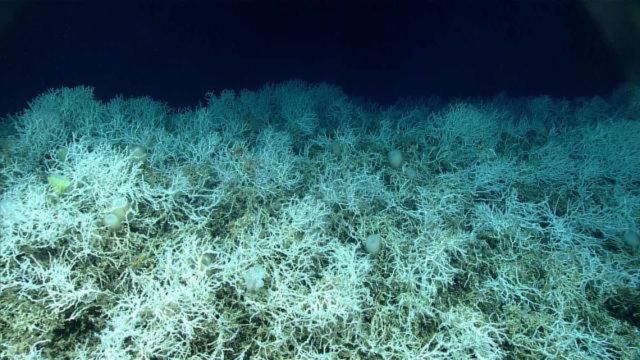According to National Oceanic and Atmospheric Administration Ocean Exploration, the world’s largest deep-sea coral reef has been found off the East Coast. It is a vast 6.4 million acre seascape that runs from Miami to Charleston, South Carolina.
According to NOAA, that makes it larger than Vermont.
The result refutes a long-held theory that the Atlantic’s Blake Plateau might be a dead zone. It was published on January 12 in the journal Geomatics.
Rather, they discovered a “stunning” ecology with “dense thickets of the reef-building coral” as its inhabitants.
“We believed for years that a large portion of the Blake Plateau was soft sediment and sparsely populated,” stated NOAA Ocean Exploration Operations Chief Kasey Cantwell in a news release.
“Past studies have highlighted some coral in the region, particularly closer to the coast and in shallower waters, but until we had a complete map of the region, we didn’t know how extensive this habitat was, nor how many of these coral mounds were connected.”

The reef is located between 35 to 75 miles from the coast, starting southeast of Miami, Florida, and extending north to Charleston, South Carolina, according to NOAA.
The largest section of the reef, known as “Million Mounds” among scientists, is mainly composed of a type of hard coral found at depths ranging from 656 to 3,280 feet. The water temperature in this area averages around 39 degrees, as mentioned in the study.
According to the authors, “cold water corals like these grow in the deep ocean where there is no sunlight and servive by filter-feeding biological particles.”
“While they are known to be important ecosystem engineers, creating structures that provide shelter, food, and nursery habitat to other invertebrates and fish, these corals remain poorly understood.”
In 2019, there were signs of a gigantic reef, but before the discovery was made public, scientists waited for the reef to be mapped by a multi-agency effort.
A virtually full map was produced by combining data from over thirty multi-beam sonar mapping studies (as well as twenty-three submersible dives). As stated in the news release, the scientists “identified 83,908 individual coral mound peak features” during this approach.
According to the experts,“the study documents the massive scale of the coral province, an area composed of nearly continuous coral mound features that span up to 500 kilometers (310 miles) long and 110 kilometers (68 miles) wide.”
High-density mounds up to 158 miles long and 26 miles wide are found in a “core area,” according to the paper.
The Ocean Exploration Trust, the University of New Hampshire, the Bureau of Ocean Energy Management, Temple University, and the U.S. Geological Survey were also involved in the multi-year exploration effort in addition to NOAA Ocean Exploration.
Derek Sowers, lead author of the study and Mapping Operations Manager for the Ocean Exploration Trust, said, “This strategic multiyear and multi-agency effort to systematically map and characterize the stunning coral ecosystem… is a perfect example of what we can accomplish when we pool resources.”











Leave a Reply